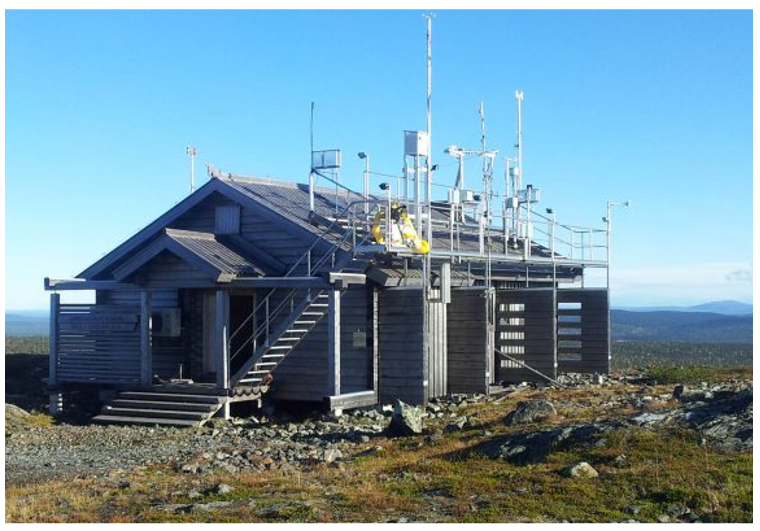Pallas-Sodankylä Atmosphere-Ecosystem Supersite, FI

Pallas-Sodankylä Atmosphere-Ecosystem Supersite
The research station consist of a clean air research station in Pallas and the Arctic Space Centre in Sodankylä. The distance between the two sites is 125 km. Both units are hosted and owned by the Finnish Meteorological Institute.
Pallas is a research installation is focussing on atmospheric composition and atmosphere-ecosystem interactions. The Arctic Space Centre in Sodankylä hosts programmes exploring upper-air chemistry and physics, atmospheric column measurements, snow/soil physics, biosphere-atmosphere interaction, and satellite calibration-validation studies.
The Finnish Meteorological Institute who owns the stations has a long history of atmospheric monitoring at Pallas; the first weather station was established near Lake Pallasjärvi in 1935. The measurements of atmospheric composition were started in 1991, and the Sammaltunturi station was established as a node of the Pallas–Sodankylä Global Atmosphere Watch (GAW) station in 1994.
Contribution to POLARIN key research challenges: 4, 5, 6, 7
Contact
Station manager Antti Hyvärinen (in Pallas), antti.hyvarinen[at]fmi.fi
Station manager Leena Leppänen (in Sodankylä) leena.leppanen[at]fmi.fi
Website
https://fmiarc.fmi.fi
https://www.interact-gis.org/Home/Station/22
Location
The Pallas facility is in western Lapland (67°58’ N, 24°07’ E) in Pallas fell. The station is part of a national park with limited access to the public.
The Sodankylä facility (67°22’ N, 26°39’ E) is in central Lapland within the boreal forest region. The station is not part of any national park, but the area (c. 2 km2) is dedicated to atmospheric and geological research, and therefore has limited public access. The area is surrounded by forest and wetland owned by the Finnish government.
Facilities
The Pallas station consists of research infrastructure for monitoring and studying the atmosphere, ecosystems and their interactions. The research area hosts four sub-sites with different research programs within a 5 km radius, covering different micro-environments: top of an arctic fell, an elevated forest clearing, a forest site and a subarctic fen. The Pallas facility has 7×7 km airspace up to 2km AGL: permission to fly Beyond Visual Line Of Sight (BVLOS) – through clouds or long transects
The Sodankylä station was established in 1949, but continuous homogenized synoptic weather records have been made since 1908. The facility consists currently of multiple buildings (1500 m2 in total). The Sodankylä facility hosts programs exploring upper-air chemistry and physics, atmospheric column measurements, snow/soil physics, biosphere-atmosphere interaction, and satellite calibration-validation studies.
Both Pallastunturi and Sodankylä host observatories belonging to: (1) GAW , (2) ICOS , (3) ACTRIS, (4) eLTER, (5) EMEPDEIMS(-SDR) , (6) ISMN, E2S, (7) EISCAT, (8) EPOS , (9) EUBREWNET, (10) FLUXNET, (11) GCW, (12) GRUAN, (13) TCCON, (14) CIMO Testbed, (15) NDACC, (16) EUVDB, (17) WOUDC, and COCCON.
Listing of the hosted observatories are provided in the bottom of the page in numerical order.
Services offered
Pallastunturi: Participation in Pallas cloud experiments to study aerosol-cloud interactions. Access to sub-Arctic UAV base for atmospheric vertical profiles.
Sodankylä: Utilisation of the Arctic Space Centre installation’s research programmes.
What is included in the Access
Unit of access: User/day
Modalities of access offered: In-person access, remote access
The access provider gives logistical support and hosts the visitors on site during the access. Observatories and support facilities are at the use of the visitor. Provision of additional instruments. The typical duration of work is between 10 to 15 access days per person. Long-term installation of instrumentation is also possible. Typically, thematic measurement campaigns are planned and executed in collaboration with the visitors.
Availability for Access
See the table in the dedicated Transnational Access call page.
Time frame for access preparations
The time frame for access preparations (documentation, logistics) depends on the planned study. Users granted access to Pallas-Sodankylä stations should contact the station manager for consultion on the time required for the arrangements.
Permits, licenses and training
Permits and licenses are needed for e.g. flying drones, installing instrumentation on private land or taking soil or vegetation samples from private land. At Pallas, the airspace permit for flying UAV’s has been pre-arranged. Only the Operator- license is needed for flying an UAV.
Medical guidelines
No specific medical requirements.
Listing of the linked observatories
(1) Global Atmosphere Watch, https://community.wmo.int/en/activity-areas/gaw
(2) Integrated Carbon Observation System, https://www.icos-cp.eu
(3) ACTRIS, https://www.actris.eu/
(4) Integrated European Long-Term Ecosystem, critical zone and socio-ecological Research, https://elter-ri.eu
(5) European Monitoring and Evaluation Programme (EMEP) https://deims.org/networks/a020d91b-500b-474e-948b- cf5856121cb2
(6) International Soil Moisture Network, https://ismn.earth/en/networks/?id=METEROBS
(7) Incoherent scatter radar system, operated by EISCAT Scientific Association, https://eiscat.se
(8) European Plate Observing System, https://www.epos-eu.org
(9) Brewer Ozone Spectrophotometer Network, https://eubrewnet.aemet.es/eubrewnet
(10) https://fluxnet.org
(11) Global Cryosphere Watch, https://globalcryospherewatch.org/cryonet/
(12) Global Climate Observing System (GCOS) Reference Upper-Air Network, https://www.gruan.org/
(13) Total Carbon Column Observing Network, http://www.tccon.caltech.edu
(14) https://community.wmo.int/en/activity-areas/imop/cimo-testbeds-and-lead-centres
(15) Network for the Detection of Atmospheric Composition Change, https://ndacc.larc.nasa.gov
(16) European UV Database, http://uv.fmi.fi/uvdb/
(17) World Ozone and Ultraviolet Radiation Data Centre, https://woudc.org